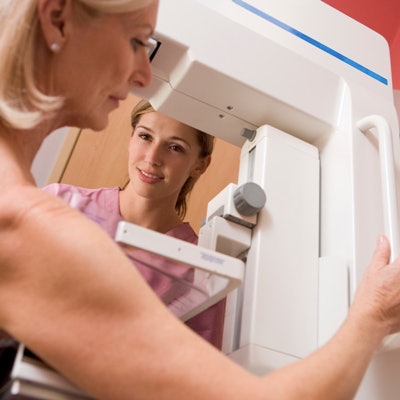
When it comes to how often a woman undergoes mammography screening, her own choice and her doctor's advice have more influence than official guidelines, according to a study published online in the Journal of Women's Health.
Researchers found that the 2009 breast cancer screening guidelines from the U.S. Preventive Services Task Force (USPSTF) did not result in longer screening intervals during the three years following their release, despite widespread concern that they would.
In fact, screening interval time actually shrank for some populations of women at higher risk of breast cancer, wrote the team led by Karen Wernli, PhD, from the Group Health Research Institute in Seattle (J Womens Health, February 8, 2017).
"To some extent, the lack of change in mammography screening intervals could potentially be driven by patient choice," Wernli and colleagues wrote. And a bigger driver may be physicians' recommendations to their patients, they added.
Interval increases?
The USPSTF's 2009 guidelines recommended that women between the ages of 50 and 74 undergo biennial mammography screening, and that women between the ages of 40 and 49 consult with their doctors regarding an appropriate screening interval, depending on their risk. The task force repeated this guidance in both 2012 and 2016.
To evaluate how this recommendation might have affected screening intervals, Wernli and colleagues used data from the Breast Cancer Surveillance Consortium (BCSC) on 821,052 mammograms received between 2006 and 2012 by women ages 40 to 74. The pre-USPSTF period was defined as October 2006 to November 2009, and the post-USPSTF period was defined as December 2009 to December 2012.
Of the total number of mammograms included in the study, 458,325 were acquired in the pre-USPSTF period and 362,727 in the post-USPSTF period. There were few differences in breast health characteristics between the two periods, but in the post-USPSTF period, women were more likely to have a college degree, higher income, and live in an urban location.
Wernli and colleagues found that changes in screening intervals were minimal. For example, among women ages 40 to 49, the mean screening interval decreased from 17.2 months to 17.1 months. The biggest interval change after the 2009 guidelines was among women with a first-degree family history of breast cancer, those with prior breast biopsy, and those with a five-year breast cancer risk, the authors wrote. But these changes were decreases in screening intervals, rather than increases.
| Change in breast screening interval after USPSTF guidelines | ||
| Patient characteristics | Mean interval in months, pre-USPSTF 2009 guidelines | Mean interval in months, post-USPSTF 2009 guidelines |
| Age | ||
| 40 to 49 | 17.2 | 17.1 |
| 50 to 59 | 17 | 16.7 |
| 60 to 69 | 16.4 | 16.1 |
| 70 to 74 | 16 | 16.2 |
| 1st-degree relative with breast cancer | ||
| No | 17.2 | 17.1 |
| Yes | 16.4 | 15.7 |
| Prior breast biopsy | ||
| Aspiration only | 16.8 | 16.6 |
| Biopsy only | 16.7 | 16.1 |
| Biopsy and aspiration | 16.2 | 15.8 |
| 5-year breast cancer risk (%) | ||
| < 1 | 16.8 | 16.7 |
| 1-1.66 | 16.5 | 16.3 |
| 1.67-2.49 | 17.1 | 17.1 |
| ≥ 2.5 | 16.4 | 15.8 |
"The 2009 USPSTF recommendation did not lengthen the average mammography interval among women routinely participating in mammography screening," the authors concluded.
Further research needed
The study indicates that guidelines alone -- even from the USPSTF -- aren't sufficient to change physician practice, Wernli's team wrote. In fact, the majority of physicians reported not changing their clinical practice due to the 2009 recommendations, and they continued to order annual mammography for women beginning at age 40, including internal medicine physicians (77%), family medicine doctors (74%), and ob/gyn specialists (98%).
But Wernli and colleagues did acknowledge that their study evaluated only the period just after the release of the USPSTF's 2009 screening recommendations, and that further research is needed to evaluate changes in practice patterns and women's screening compliance since then.
"Additional studies of mammography screening might be able to further address changing interval length with additional data," the group wrote. "With new national guidelines released in 2016, it will be important to investigate changes in physician practice across specialties to evaluate the alignment of practice with evidence-based care."




















